A drill is one of the most essential tools in the house. This handy tool is always ready to provide solutions for every homeowner, from drilling nails to removing rust to any woodwork. To make it easy for you, let’s find out more about corded vs cordless drills and pick the right tool.
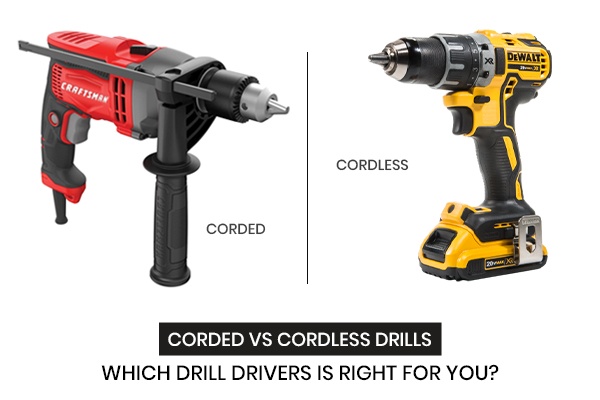
Power drills make the entire process of drilling easy and effective. When it comes to the types of drills, they vary in their capabilities, features, power consumption, and design. The main difference everyone looks for is in the corded and cordless designs.
You might think both are almost similar, but you would be surprised to know how significantly different they are and how much that impacts their performance. Aside from the aesthetic differences, there’s also a significant variation in functional issues.
This is why it is vital to check the design before you buy a drill. To make it easy for you, let’s find out more about corded vs cordless drill and pick the right tool.
Main differences of Corded vs Cordless Drill
Here are the key differences between the two power tools:
- Corded drills possess higher power as they are directly connected to the electricity supply. In contrast, cordless drills are weaker with limited battery life. They also perform less vigorously compared to corded tools.
- Corded drills are not mobile. They cannot be carried everywhere without a plug socket. On the other hand, cordless drills have the advantage of being easily transported everywhere. They run on charged batteries or lithium-ion batteries.
- Corded drills are more powerful and durable as compared to cordless drills. Cordless drills last max 3 hours on a full charge and will start performing poorly once it runs out of power.
Corded Drills
Corded tools have been in use since the invention of drills and haven’t been phased out by newer technology. Their power and capabilities are top-notched, given that they are not limited to batteries and can run on any power outlet. Based on their features and capabilities, corded drills are of four types:
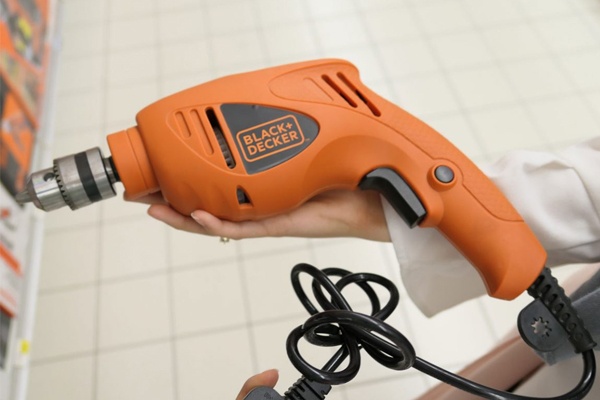
Rotary Drill
This tool is a high-powered drilling machine specially designed for heavy-duty performance. It is common to find these at construction sites.
Angle Drill
This power tool is used to drill into small and tiny corners. Electricians and plumbers commonly use the angle drill.
Drill Driver
The standard multipurpose drill is the drill driver, which is the most common tool used by everyone. It has the power to handle almost all projects and attain the best results.
Hammer Drill
This one is similar to a cordless hammer drill, but it’s heavier to carry and quite pricey. The best hammer drills can be used for multiple purposes, such as drilling into the stone or any other concrete material.
Elements of Corded Drills
Cord Length
One of the critical concerns with corded drills is the extension cord used to derive power. It limits the work and, at times, hinders work efficiency at specific angles. Sometimes, these drills come with shorter cords which can be an obstacle.
The wire should be long enough to help you work comfortably at any angle. Another essential feature to remember is the material of the extension cord. Some cables are of poor quality, which can lead to short circuits or breakage. The power cord needs to be flexible and sturdy to avoid such risks.
Chuck
The chuck in drilling machines determines how well the device can operate and the accessories it can be paired with. The wider the hole, the better the chuck, with the smallest hole being 10mm.
Corded drills are two types: with key and keyless. The key helps keep the chuck in place, while keyless chucks can be changed frequently. You can opt for a chuck with keys to have more impact.
Speed Control
If corded drills are directly connected to the power source, the speed is higher and stronger. Speed control is an optional choice in these corded tools. Some models come with a single-speed which can restrict its use to specific projects only.
Sometimes, a high speed can damage the project and cause unnecessary trouble. It is better to look for corded drills with variable speed options. It will help you work on different projects. All you need is to set your speed based on the task.
Direction Switch
The direction switch determines the direction to the drill turns. It is used to facilitate the loosening of screws or dismantling materials quickly based on their twist. You can switch one way to dismantle them and hit the other way to fix them back in. It is beneficial to have a directional switch to toggle between the two rotational cycles of drills.
Features of Corded Drills
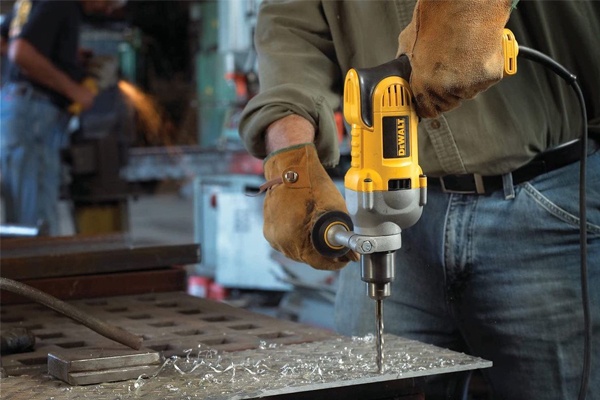
- Corded tools are used for drilling hard materials such as wood, plastic, metal, and concrete. They can penetrate all kinds of household materials.
- They use the electrical output to derive power.
- Different grip options are available in corded drills. You can choose what suits you right.
- They come in either single or variable speed.
- Additional accessories can be attached to increase its functionality.
Pros
- Offers high power and speed
- Efficient ‘Plug and Play functionality
- Cheaper
Cons
- Requires electrical output and extensions
- It can be a hassle
- High power – end up ruining the project
Cordless Drills
Cordless drills are more popular among new homeowners and DIYers for their ease of use. They are powerful tools with highly charged batteries. Due to their wireless nature, cordless drills are more transportable and flexible. They are a hassle-free power tool making them a favorite for handcrafted.
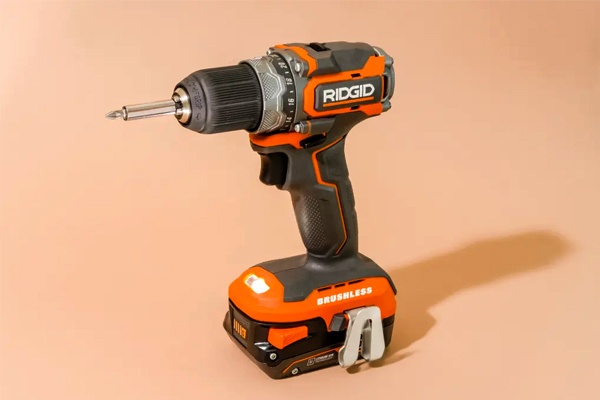
Unlike corded drills, cordless ones do not have to be plugged in constantly. Instead, they use batteries or have in-built rechargeable batteries for power.
This helps to control the output and create delicate innovations with accuracy while providing unique torque. Electric drills today come in creative and modern designs. They have exciting features like variable speed settings, in-built lights for visibility, etc. You can also add accessories for extra functionality. Cordless drills are of four types:
Drill or Drivers
This model is the standard cordless drill. It is used to drill bits, make holes, or drive screws into wood, plastic, and metal-based surfaces.
Hammer Drills
Just like the driver drills, hammer drills also have an in-built hammer setting to work on concrete, stone, and brick. They are heavier than regular drills and need extra power for better performance.
Impact Drivers
The Best impact drivers are lightweight and serve the primary function of driving and loosening screws or bolts. They are super handy when you make furniture.
Rotary Hammer Drills
They are very similar to hammer drills but with the minor exception of using an air pressure mechanism to provide the same results. They are heavier and more pricey compared to regular hammer drills.
Elements of Cordless Drills
Battery Options
There are two types of battery options in these power tools: type of battery and voltage. Both nickel-cadmium and lithium-ion batteries are used to power up cordless tools. Opt for tools that run on lithium-ion batteries as nickel and cadmium are toxic and harmful to the environment.
The latest versions of cordless drills use lithium batteries. Voltage can determine the torque that the drill can produce. Opt for the voltage of cordless drills depending on your need.
Chuck
Similar to chucks in corded drills, chucks in cordless ones too are with key and keyless. The chuck helps determine the width of the hole and what the drill can be used for. Always go for tools with a keyless chuck as it’s easier to change your drill and add accessories.
If the work demands single speed and torque, keyed chuck is beneficial as there is no need for replacement.
Directional Drills
With directional drills, you can determine the direction you’re drilling in. The rotation button can help you either drill a screw into the wood or remove them. It makes the work easier and faster.
Speed Control
Cordless drills come with a speed controller. It allows you to control the speed as per your preference. You can change the speed with your thumb on the trigger. Your grip should always be firm for all speeds, and controlled friction should be applied irrespective of the material you’re drilled into. Speed control allows you to handle both delicate work and extensive drilling.
Clutch
The clutch essentially works to slow down your drill from overdriving. It reduces the speed of the drill’s head and maintains accuracy. Many cordless drills come with different clutch settings. You can set them up based on your task.
Work Light
With the easy portability of cordless drills, work lights come in handy to work on delicate projects. It helps ensure you can handle every nook and corner with ease while safeguarding your hands from any harm. The work light starts dimming if the battery is low. That’s your cue to charge the drill back up.
Features of Cordless Drills
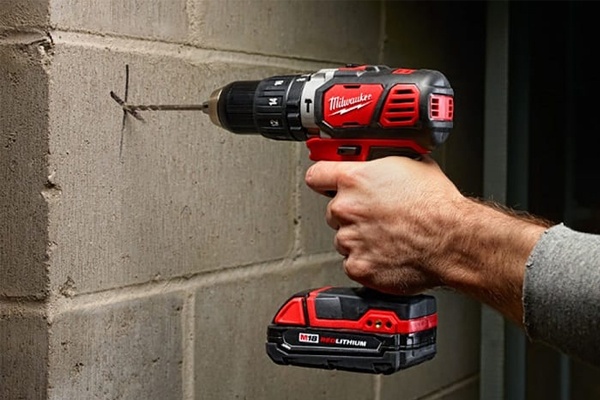
- It can drill into wood, plastic, metals, and concrete with ease and accuracy.
- It is ergonomic to handle.
- Cordless drills have in-built batteries to power the device.
- Its speed can be adjusted.
- Cordless tools are portable and mobile.
- Various accessories can be easily attached to a cordless device.
- They come with a work light for easy handling.
Pros
- Mobility and convenience
- Greater control and precision
- Variable speed – handle the machine with ease.
Cons
- Lesser power
- Charging required
- Expensive
What to Look Out For?
When buying a drill, you will have to keep the following points in mind to choose the right tool.
Power, Speed, and Torque
These three are the key factors to consider when you buy a drill. It determines your power consistency and impacts your drilling. When it comes to power, corded tools are long-lasting and have consistency. Cordless ones may quickly run out of power and delay the process.
Weight and Size
Aside from power and torque, you should be very comfortable in handling the drill. The weight of the power tool is crucial so you can perform your tasks smoothly without any trouble. In this case, cordless tools are lighter than corded tools.
Mobility
Mobility is essential as it helps you work on delicate corners effectively. Corded drills are limited to their power cord’s length, while cordless drills can be convenient to address delicate drilling tasks.
Grip
Both cordless and corded come with ergonomic handles with an option of additional grip to meet your needs. It is better to test the drill before you buy one.
Brand & Budget
Brand plays an important role when you decide on a drill to buy. Always go for reputed brands with good reviews and make sure you buy from an authorized seller with a warranty. Your budget also counts. Corded or cordless, both types of drills perform similar functions, but it all comes down to the price.
Which one should you get?
Corded drills are much preferred for their consistent power drilling. They are reliable and come at a lower price. If you’re planning to start a project that involves extensive drilling, go for a corded tool.
But if your work is light and has to navigate delicate corners, pick a cordless drill. It is more efficient, portable, and extremely handy for frequent drillers. You can charge and use it whenever you want.
In the battle of corded vs cordless drill, it all comes down to what work you need the drill for. We have provided the best drill drivers which consist of both corded and cordless drills. Determine your task and pick the right drill to fulfill your needs.

Leave a Reply